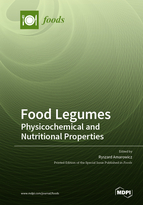Food Legumes: Physicochemical and Nutritional Properties
A special issue of Foods (ISSN 2304-8158). This special issue belongs to the section "Grain".
Deadline for manuscript submissions: closed (30 June 2018) | Viewed by 39266
Special Issue Editor
Interests: analytical chemistry; polymer chemistry; food science
Special Issues, Collections and Topics in MDPI journals
Special Issue Information
Dear Colleagues,
Legumes are an important source of nutrients (proteins, carbohydrates, water soluble vitamins, minerals). They play important role in chronic disease prevention. The beneficial effects of legumes are attributed to the presence of legume seeds starch with a low glycemic index, dietary fiber (soluble and insoluble), several classes of phenolic compounds, and oligosaccharides. Phenolic compounds of legumes possess strong antioxidant and antimicrobial activities. Oligosaccharides, acting as prebiotics, modify intestinal microbiota.
Some of the bioactive compounds present in legumes (e.g., trypisin inhibitors, condensed tannins, lectins, phytates) also exhibit antinutritional effects—decreased protein digestibility and availability of mineral compounds. Technological processes (non-thermal and thermal processing, hydrolysis, fractionation) can modify the functional properties (emulsifying activity and stability, foaming properties, water holding capacity) of legumes and legume products, as well as modify the activity of bioactive compounds present in legume seeds.
Prof. Ryszard Amarowicz
Guest Editor
Manuscript Submission Information
Manuscripts should be submitted online at www.mdpi.com by registering and logging in to this website. Once you are registered, click here to go to the submission form. Manuscripts can be submitted until the deadline. All submissions that pass pre-check are peer-reviewed. Accepted papers will be published continuously in the journal (as soon as accepted) and will be listed together on the special issue website. Research articles, review articles as well as short communications are invited. For planned papers, a title and short abstract (about 100 words) can be sent to the Editorial Office for announcement on this website.
Submitted manuscripts should not have been published previously, nor be under consideration for publication elsewhere (except conference proceedings papers). All manuscripts are thoroughly refereed through a single-blind peer-review process. A guide for authors and other relevant information for submission of manuscripts is available on the Instructions for Authors page. Foods is an international peer-reviewed open access semimonthly journal published by MDPI.
Please visit the Instructions for Authors page before submitting a manuscript. The Article Processing Charge (APC) for publication in this open access journal is 2900 CHF (Swiss Francs). Submitted papers should be well formatted and use good English. Authors may use MDPI's English editing service prior to publication or during author revisions.
Keywords
- Nutritional composition of legumes
- Phenolic compound and their activity
- Oligosacchaccharides and fiber
- Antinutrients
- Legume processing
- Physicochemical properties of legume starch and proteins
- Effect of processing on nutrients and bioactives







